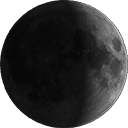Having been unable to see Aldebaran in the clear sky through any of my optics all day, and with clouds rolling in from the West, Bridgit and I decided not to alter prior plans in the hope of seeing the likely invisible. We would head out for the evening, but stop briefly along the way, at just the right moment, in case some miracle, or scientific oddity, might yet allow us to see the occultation. On a whim and experience, I decided that spending the time to set up more complex optics would both make us late and not increase the odds of finally seeing Aldebaran in daylight, and so resolved to look with only a quick-to-grab 12×50 binocular.
We misjudged how long it would take to arrive at a suitable exit off of Route 95, and so parked in an industrial yard in Sidney at 6:48pm, just in time to scramble for the observation. Bridgit decided to join the fool’s errand, and grabbed an 8×40 binocular. The Moon was easy enough to see, yet where SkySafari said Aldebaran would be, there was, at first, only clear, blue sky. We planned to observe until a few minutes past the predicted time, to be sure not to miss the occultation simply for lack of looking. Suddenly, only a minute before it was to touch the edge of the Moon, Aldebaran appeared exactly where it was meant to be! It was faint, yet clearly discernible. It pulsated in and out of view several times in the next minute, a result of the blurring effect of handheld binoculars on a faint object buffeted by daytime seeing. Then, at exactly the predicted time, and in a moment when it happened to be convincingly still, Aldebaran spontaneously vanished and did not return, having ducked behind the dark limb of the Moon!
Upon arriving at the theater, we sat in the back row, on the aisle. This allowed my quick, discreet escape at five minutes before Aldebaran’s scheduled 7:52pm reappearance. Upon noting that it was dark outside, it became immediately apparent that warnings about the difficulty of observing Aldebaran’s emergence from behind the glare of the Moon’s bright crescent did not apply to us in Maine. Those warnings were for astronomers farther West, who were watching the same event in their afternoon or morning sun. Aldebaran emerged from behind the Moon at exactly the predicted time and location, a bright point of light suddenly created along the edge of the Moon, set clearly against the black sky.
The effects of the occultation of a star are significantly different from those of a planet. When Venus vanished behind the Moon early this past winter, it faded slowly, its disk gradually receding out of sight. (It reëmerged after the Moon set, so I did not see that.) Stars are much closer to true point sources, and so pop in and out of view more nearly instantaneously. The beauty is not only in the novelty, but in seeing the physical properties of the cosmos confirmed with one’s own eyes. I know the different results of the Moon occulting a planet versus a star not because I have read about them in a book, but because I have seen them. I may not be Isaac Newton, or even Isaac Murphy, yet I can follow the derivations of reality discovered by legions of ancient natural philosophers and modern physicists.
One mystery remains: Why, at ingress, did Aldebaran appear along the edge of the Moon only a minute before being occulted? I had been looking along its predicted path for hours and it appeared exactly where it was expected, yet it was lost in the bright daylight until the last minute. The Moon has no atmosphere, so there was no effect of atmospheric lensing concentrating the light. Might there have been some gravitational lensing? The Moon lacks both the mass and the distance from the Earth to change Aldebaran’s apparent position, yet may its limb have refracted just enough additional starlight as to have brightened Aldebaran into view? The most likely answer is due to some much simpler physical phenomenon that I have yet to learn. Such are the ways of science, and the attractions to a love of astronomy.
Colin sent this report:
“I was in Massachusetts at 8:10 p.m. when I looked up at the moon and spotted a star on the lit side of the crescent. It took about 2 seconds to realize that an occultation of Aldebaran had occurred, and that the location suggested the event had happened about 1.5 hours earlier. Aldebaran must be right in the middle of the Moon’s freeway in the sky, as it and Antares, another red supergiant star, are often occulted.
“Hope you all in Maine got a chance to see it blink out when it hit the ingress side. Boggling to get a sense of the distance, diameters and speeds of the bodies involved… how a creeping moon can obscure a huge star so far away, and that it actually takes a perceptible fraction of a second to disappear because of the immense size of the star, and that it’s real and visible to witness.
“Love this hobby!”






